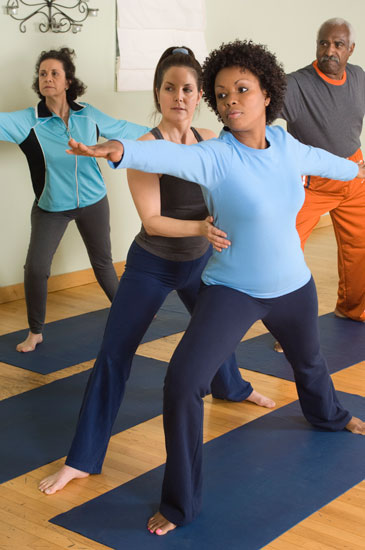 Participating in yoga is relatively safe, according to a new study from researchers at the University of Alabama at Birmingham who conducted the first large-scale examination of yoga-related injuries. Their conclusions? Injuries are more common in older participants, and having a qualified instructor is important.
Participating in yoga is relatively safe, according to a new study from researchers at the University of Alabama at Birmingham who conducted the first large-scale examination of yoga-related injuries. Their conclusions? Injuries are more common in older participants, and having a qualified instructor is important.
Yoga is an increasingly popular practice in America. The Yoga in America Study, commissioned by the Yoga Journal and Yoga Alliance, says 36.7 million Americans participate in yoga. UAB researchers from the Center for Injury Sciences studied data from the National Electronic Injury Surveillance System compiled from 2001 and 2014 for the study published in the Orthopedic Journal of Sports Medicine.
“Yoga injuries are relatively rare, and as you might expect, the incidence tends to rise with the age of the participant,” said Thomas Swain, MPH, a research assistant at the Center for Injury Sciences and first author of the study. “We did find that the injury rate is increasing over time, which may be a reflection of the increase in popularity of yoga, leading to an increase in inexperienced participants who do not take the necessary precautions to avoid injury.”
Swain’s team found the overall rate of yoga-related injuries climbed to 17 per 100,000 participants in 2014, up from 10 per 100,000 in 2001. The injury rate for older participants was higher. Those 65 and older experienced an injury rate of 58 per 100,000. Individuals ages 45-64 saw an injury rate of 18 per 100,000, while those between 18-44 years of age had an injury rate of 12 per 100,000.
Overall, the team found 29,590 yoga-related injuries during the study period. Nearly half were injuries to the trunk, and sprains or strains accounted for 45 percent of all injuries.
“The incidence of fracture was highest in the older population, some three times higher than in the younger population,” Swain said. “For all injuries, the actual risk might be higher than our numbers show, as we surveyed results only from those who sought medical attention in an emergency department.”
As with any sport or physical activity, the authors say it is important to be sure you are physically capable of the undertaking.
“Talk to your physician before taking up yoga, be cautious, and recognize your personal limitations, particularly if you are over 65,” Swain said.
| “You need a realistic view of your own abilities, and you need to understand that some poses might be too challenging and inappropriate. A qualified, certified yoga instructor can help you with that assessment and is essential to a safe experience.” |
“Yoga is harder and more demanding than some people believe,” said Gerald McGwin, Ph.D., the director of the Center for Injury Sciences and a co-author of the study. McGwin took up yoga on the advice of a physician following a running injury. “You need a realistic view of your own abilities, and you need to understand that some poses might be too challenging and inappropriate. A qualified, certified yoga instructor can help you with that assessment and is essential to a safe experience.”
Stephen Fletcher, owner of the Yoga Circle, is a certified yoga instructor. He recommends looking for an instructor who is certified by the Yoga Alliance, the largest nonprofit association representing the yoga community.
“You want an instructor who has had good training and has some experience in the field,” Fletcher said. “To avoid injury, you want someone who has a good understanding of anatomy and understands how muscle groups interact and align.”
When starting out in yoga, Fletcher says to look for a slower-paced yoga class for an introductory experience. Smaller classes could be beneficial as well, as the instructor may have more time to work one-on-one with each participant.
Swain and McGwin also suggest that national standards for yoga instructor certification should be created and that safety and injury prevention information should be aggressively taught to all yoga practitioners.
“There are many benefits to yoga, and overall our findings show it is relatively safe,” McGwin said. “But there is an injury risk, especially for older populations, and that risk should not be ignored.”
The Center for Injury Sciences is part of the Division of Acute Care Surgery, Department of Surgery, in the UAB School of Medicine. McGwin is also a professor of epidemiology in the UAB School of Public Health.